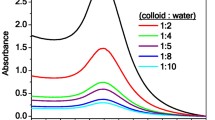Abstract
Formation of particle aggregates of arbitrary size and shape by lumping of small particles yields extinction and scattering of light that differ from those of isolated particles.
The aggregation process can be followed from extinction and angle-resolved light scattering measurements. Introducing new parameters in angular light scattering, systems containing only isolated clusters were efficiently distinguished from cluster-aggregate systems. This was achieved by evaluation of the measured data in forward and backward scattering direction and at a scattering angle of 90°, resulting in a distinct separation of isolated-cluster systems and cluster-aggregate systems. For measuring the angle-resolved light scattering by noble metal colloidal particle systems, a common photogoniometer setup had to be modified. Changes in scattering and extinction data were qualitatively described by a model that takes into account electromagnetic coupling among clusters in the aggregate.
Similar content being viewed by others
References
L. Garbowski: Ber. Dtsch. Chem. Ges.36, 1215 (1903)
E.J.W. Verwey, J.Th.G. Overbeek:Theory of the Stability of Lyophobic Colloids (Elsevier, Amsterdam 1948)
P. Meakin: Phys. Rev. Lett.51, 1119 (1983)
P. Meakin, T. Vicsek, Fereydoon Family: Phys. Rev. B31, 564 (1985)
Fereydoon Family, P. Meakin, J.M. Deutch: Phys. Rev. B57, 727 (1986)
O.R. Crutzan: Q. Appl. Math.20, 33 (1962)
D. Langbein:Springer Tracts Modern Phys. 72, 73 (Springer, Berlin, Heidelberg 1972) Chap. 5
B. Jeffreys: Geophys. J. R. Soc.10, 141 (1965)
G. Mie: Ann. Phys.25, 377 (1908)
M. Quinten, U. Kreibig: Appl. Opt.32, 6173 (1993)
M. Quinten, U. Kreibig: Surf. Sci.172, 557 (1986)
M. Quinten, U. Kreibig: Z. Phys. D12, 521 (1989)
P.B. Johnson, R.W. Christy: Phys. Rev. B6, 4370 (1972)
L. Genzel, T.P. Martin, U. Kreibig: Z. Phys. B21, 339 (1975)
L. Genzel, U. Kreibig: Z. Phys. B37, 93 (1980)
L. Tsang, J.A. Kong, R.T. Shin:Theory of Microwave Remote Sensing (Wiley, New York 1985) pp. 173–174. Note that in 32) on p. 173 there is a mistake. It must be\(t_1^1 \left( {\cos \theta } \right) = - \sqrt {3/2} \)
Author information
Authors and Affiliations
Rights and permissions
About this article
Cite this article
Kahlau, T., Quinten, M. & Kreibig, U. Extinction and angle-resolved light scattering from aggregated metal clusters. Appl. Phys. A 62, 19–27 (1996). https://doi.org/10.1007/BF01568082
Received:
Accepted:
Issue Date:
DOI: https://doi.org/10.1007/BF01568082




